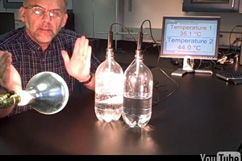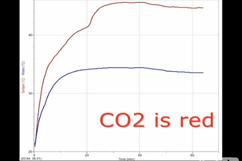

Avoiding Flawed
Demonstrations:
Greenhouse Effect
Intro/Index
Faulty Demos
Errors, Misconceptions
Testing, Lab Results
Scientifically Strong
Resources
Rebuttals
Acknowledgements
Contact
** Lab Results **
Test after test:
there just
were not any
real, measurable
temperature differential
signals.
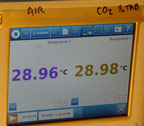

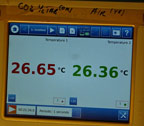
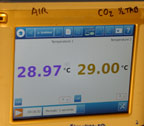
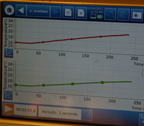
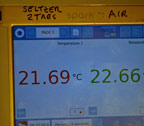
The air samples
were as
likely to
be slightly
higher than the CO2
as the other way around.
At 40 cm distance
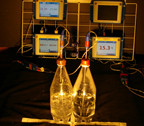
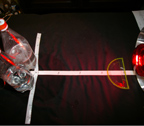
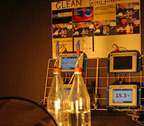
Three runs at a time
at 5 cm distance

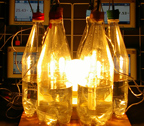
Different Amounts
of Alka Seltzer
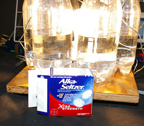

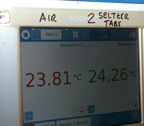
Various types of
incandescent lamps,
varying wattages
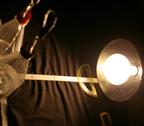
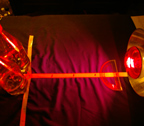

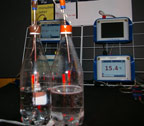
Room Ambient Temp
Monitored
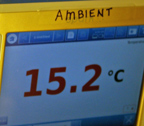
Calibration of
temperature probes.
All seven track together
within
0.2 Celsius from
5 to 60 degrees C.
Most within 0.05
C
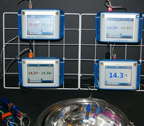



Thank you,
Pasco Scientific
This web portal
is a resource within
America's online library
for Education &
Research
in Science,
Technology,
Engineering,
Mathematics:

|
 |
Review of the CLEAN "Greenhouse Gas in a Bottle Demonstration"
Based on: demo video; lab tests; communication with CLEAN representatives; and discussion among educators, scientists & students.
|

Results of Lab Tests Conducted
by the Mobile Climate Science Labs
|

Misconceptions and
Errors found in demo, include:
| 
Value as a Case Study
|
Based on test results, including having replicated the
demo as it appears in the video:
• Does not produce results claimed. All test runs
consistently produced temperature differentials
between the gas samples that were too small to
measure with
equipment available to educators.
• Demo tends to spread confusion, rather than
deepen a scientific understanding of the basics
of global warming and "the greenhouse effect."
• Regarding the claim made that this is an "easy"
demo
to do: This is inaccurate:
== Experience of several other labs has shown
that producing an authentic measurable temperature
differential
in gas samples due to absorption of
infrared energy
is actually quite difficult among
demonstrations
currently available on climate
change, global
warming
science, and "the
greenhouse effect". For example.
== To stress that something is easy tends to
discourage teachers for asking for help or asking
questions. When teachers come to us asking for
help in doing this demo, they are often
embarrassed, as if we might think they are stupid
for not getting the 9 degree result. They are
relieved to hear that almost all of other teachers
we've
spoken also saw little or no differential
readings,
either
way.
== In our labs, we did not find getting a clear
differential
temperature rise to be easy at all --
until we started
to deliberately skew the layout, to intentionally force temperature differentials.
== This demo, even as shown, is of at least
moderate difficulty to
replicate,
among those
available.
== Given the vastly different results labs
independent of each other have gotten, it is
reasonable to say that the demo is more difficult to
do well than is
appreciated in the video.
(Someone had to be doing something wrong, in one
lab or
another. One needs to be careful in order to
get
repeatable, verifiable results. It is not so easy.)
== As it does not demonstrate what it claims,
the video does not indicate the true complexity of
the
necessary steps to produce a working demo
of this nature.
Note on this type of demo,
among the many
vetted demos being done about global warming:
There are many approaches taken by various
demos. Global Warming and "the greenhouse effect"
is a very rich subject. Many components of the
topic
readily lend themselves to great hands-on
science
demonstrations. Taking a multi-layer
approach more
closely
follows the way scientists
have discovered and
continue to study the basic
mechanisms of global
warming. The approach of this
demo is
not one scientists tend to
use, in part
because it is so challenging relative to the rewards.
It is not how global warming was discovered. There
are so many topics worthy of study
through
experimentation in this field -- both by scientists
and the public. There is a
significant
downside
to try to reduce hands-on
lab experiences
to only
one demonstration.
Especially with this being such
a
tough one to do right.
A great thing about hands-on science demonstrations:
You need not simply trust the findings of the Mobile
Climate Science Labs, Lawrence Hall of Science, the
US
Government, global energy corporations or any other
authority and influence in America's education system.
It is possible to replicate the demo where you
are.
Try the demo
yourself and see what results you get.
If you'd
like, we can
post your results & experience here.
We encourage you to be active in the verification process
of climate science and climate science education -- your
participation makes it stronger.
Details of test results, and methods used
will appear here soon. |
• Video describes producing a 9 degree Celsius
temperature differential. That is far in
excess of
what
scientific
theory
indicates one would
expect
to
measure under such
conditions.
No
explanation
is
offered on how
the
results
displayed in video
are
scientifically possible.
• Providing a powerful energy source which is
overwhelmingly
in
infrared and visible wavelengths
carbon
dioxide does not
absorb, yet promotes
expectation
that CO2
sample would somehow
become
substantially warmer
than air sample.
(Demos using common lamps/light
bulbs are very
difficult to do successfully, and tend
to promote
misconceptions if adequate
interpretation is not
provided.)
• Describes bottles used in the demo as "clear."
Misses the opportunity to demonstrate a central
feature of global warming and "greenhouse" gas
theory: an object that is transparent in visible light is
often not in various frequencies of infrared light
(and vice versa). This is true of solids, liquids and
gases. Without that, the "greenhouse effect" would
not exist.
The heat lamp isn't heating the gas and
water so much as it is heating the plastic bottle.
From
there, the plastic is transfering heat to the
water and
gas. Demo promotes lack of awareness
and
confusion on this.
The choice of materials made
for gas and
water containers is part of the reason
this demo does not work as claimed.
• Does not appear to address how students might
go about generating a higher signal and a lower
noise level. i.e. more energy that CO2 absorbs and
re-emits, less energy that it does not.
Also, less background heat energy that drowns out
the temperature rise signal
generated by CO2.
• In the actual Earth system, incoming solar energy
is of the
order of 1300 watts per square meter,
radiative
forcing by carbon dioxide of the order of
0.85 watts/meter sq.
The demo blasts the bottles
with energy not unlike sunlight. Would we expect
this demo set up and the equipment used to detect
the
CO2 warming signal in all
that energy noise?
• Poor lab techniques. Examples:
==
Lack of
calibration, checking for accuracy of
temperature
probes.
==
No multiple runs recommended, designed as
controls, to
bring to the surface
experimental errors.
We have great respect for
professional illusionists (magicians). A rule of theirs is "never repeat
your tricks." We, however,
should always repeat
our experiments. As a chance for the public, and
ourselves, to look for
tricks. No hidden errors.
==
Angle of the bottles
relative to heating
lamp can have a significant affect
on temperatures.
(By contract, at the 40 cm distance recommended
in the video, a millimeter or two change in distance
in this set up does not cause big temp changes)
== Parabolic reflective lamps, in particular, do
not always emit radiation in a uniform radial pattern.
Especially in infrared. (They are designed to be
fairly uniform in visible spectrum luminous
intensity, to conform to the pattern in their specs.)
Not checked, not accounted for in demo.
== Stress should be placed on care in checking
bottle seals. A leaky seal can produce markedly
lower temperatures in a sample bottle.
• Confuses the multiple steps by which global
warming is taking place. Attempts to combine
several into one, with no explanation.
Note:
Elaboration and background on each of the
above will soon be available in this sub-section.
The CLEAN Greenhouse Gas demo contains
errors
common to most of the demos
being
reviewed that we have found to contain
serious flaws.
|

•
|

Spreading Doubt, Confusion and Distrust:
This version is one of many similar versions.
Educators are being instructed to perform demos
that don't work as claimed. Feedback we receive
indicates that this is spreading doubt, confusion
and
distrust in climate science in the schools.
When educators are told that it is "easy"
to get the
results claimed, they are put in a bind:
Do they
carefully run the experiments? --
only to get no
temperature differential.
They then
risk facing
criticism
or ridicule that
they
"did the demo wrong".
Or,
do they fudge
the
results? -- intentionally or
subconsciously:
Set up the
apparatus to force the
desired
temperature
differential to appear?
That is
not hard to do. Labs work hard to avoid this.
Educators should never be put in that position.
Climate science can be well represented with
quality science demonstrations.
We must never be among those who
fake the evidence presented to the public.
Please be advised: demos such as these
can also
be used -- and are being used-- by those wishing
to "prove" that CO2 is not a greenhouse gas --
as part of smoke and mirror parlor tricks.
Fake science demos are being presented as
evidence that "global warming is a
hoax."
Faulty demos are ripe for use in deception.
Should science educators be among those
using
them, concealing how they can be
used
to
misrepresent valid science?
We can not recommend such flawed demos. |
|

ClimateChangeEducation.org has been in communication with CLEAN representatives about faulty demos such as this for some time now.
Discussion began long before CLEAN elected to promote this demonstration on its website and within its resources.
This has been in both informal and official communications.
For instance, during a recorded national teleconference, our representative was asked to elaborate about issues we saw in this type of demo.
He expressed his concern, wanting to avoid federal programs find themselves promoting "cold fusion" demos.
What an embarassment that would be for the government and science education if these demos were recommended by federally funded websites.
Unverified and erroneous claims have been publicized in the media before, such as the infamous cold fusion experiment of 1989.
Global warming is very real, just as nuclear fusion is real -- as in the sun. Yet not every science demo under the sun is what it claims to be.
We asked for the opportunity to share our experience with such flawed demos--based on lab & field work, plus discussion among science advisors.
At least one other well known and respected member of the climate science education community has also written CLEAN,
expressing his alarm over apparent lack of concern about the errors in this demo.
We have no desire to embarrass CLEAN or agencies of the US Government represented in CLEAN.
To the contrary, we have put scores of hours trying to alert agencies and their representatives about potential embarrassment.
With dismay, we've seen the unfolding of CLEAN placing the US government among the significant promoters of this type of flawed demos.
Accurate, sound science is our highest priority in the service of science education -- we can not ethically compromise on that.
As we can no longer wait to address these faulty demos publically, we can therefore not ignore CLEAN's demo. In part, as it is currently lending
the appearance of
legitimacy
to many of the faulty demos being promoted, most sharing the same basic errors.
|

CLEAN sponsors include:
National Science Foundation
NOAA
|

Educational institutions in the United States presenting this demo include:
K-12 schools, government outreach and education,
teacher professional development workshops, websites, videos.
That this demo is approved and being promoted by the United States Government agencies is a powerful force for rapid adoption and adaption.
Note: it has become a common practice to present educational materials without giving due acknowledgement and credit to their original creator.
This is not good academic etiquette or protocol, and weakens science education, we feel. Demos are frequently presented without crediting the original developer(s).
|

Safety Concerns:
An exposed heat lamp is used in the demo. Care should be exercised to protect students, teachers and the public.
Although it is not specified whether to use a more common incandescent lamp (light bulb) or an infrared heat lamp, in either case there are safety concerns to address.
Infrared heat lamps, whether the red or white/"clear" variety can get especially hot.
It is an essential practice to include demo specific safety training as part of educator professional development.
Teachers and students should be specifically warned to be careful not to touch the surface or move objects in a way that they might strike the lamp.
Regarding physical steps, recommendations include: Placing a shield around the heating lamp -- to lessen the chance of physical contact with the hot surface.
Wearing safety glasses and gloves, especially during set up and take down of demo.
Provide GFCI (ground fault circuitinterrupter ) protection is recommended: As a precaution against potential shock if a lamp were to break.
Further, as in the demo, the presenter touches the electrical socket and switch with his/her hands, at the same time the demo is being presented near sinks and water.
Demos can and must be safe. Not providing great hands-on science for the public contributes to public health and safety risks. Careful attention to safety is an absolute essential.
|
|
























